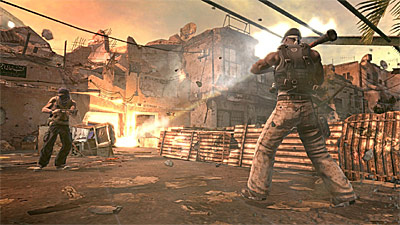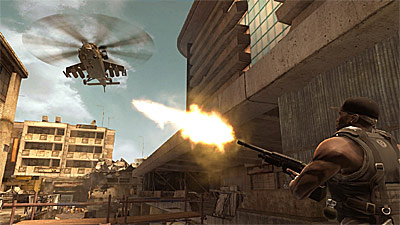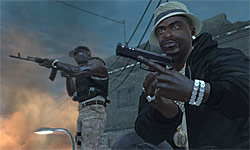In Da Video Game
Make no mistake about it: 50 Cent: Blood on the Sand is not innovative. Not even a little. Every single thing you’ll do here you’ve done before, probably lots of times.

What’s great about this title is that it rips off not a single game, but lots of games, and then puts the pieces together in a way that gives this third-person shooter its own hip-hop-heavy flavor. It’s got the cover mechanics and over-the-shoulder view of Gears of War, the vehicle sections from Halo, the slow-motion “quickdraw” feature from Gun (redubbed “Gangsta Fire Mode”), a touch of the aim assist from GoldenEye, the point on the screen directing you to your next objective from Call of Duty and Rainbow Six Vegas, and the overall feel and high-score emphasis of an on-rails arcade shooter from the ’90s. Slap on some rap tracks from 50 and his G-Unit, and you’ve got a shallow, but very addictive and playable, game.
The campaign begins with its intentionally bad story. 50 is on tour in the Middle East, but after the last show, the promoter refuses to pay the band. The rappers get violent and the promoter changes his mind; the only problem is that he doesn’t have the money. Instead, the band gets a skull that’s blinged out with diamonds and pearls. Mercenaries steal the skull, and Fiddy and his partner (you can pick another hip-hop star for the friendly A.I., or play co-op via the Internet) have to shoot their way through waves of opponents to get it back.
From there it’s killing time. For each checkpoint, you and your fellow rapper will gun down terrorists galore, racking up points and collecting money to spend on better weapons, taunts (that’s right, with a button press you can yell out lots of obscene threats), and “Counterkills” (close-range combat moves executed via quick-time events). The latter are a lot of fun to pull off (the QTEs use only one button, so it’s not Resident Evil 4-grade infuriating), but accumulating more of them actually makes the game harder: If you just have one or two of them, it’s easy to learn the timing, but with a whole bunch you’ll always be on your toes. If you miss a Counterkill, you lose some life.

The levels won’t stun you with their design, but they usually won’t irritate you, either. There’s a decent mix of enemies who, while they don’t quite act human, will often mix up their strategies by taking cover and advancing depending on the situation. Your A.I. collaborator pulls his weight without making the levels too easy (even if he stands in doorways and blocks you now and then), and you’re forced to use a combination of cover and run-and-gun techniques. Unlike in most shooters with cover, ducking down often won’t keep you out of danger long enough for your health to regenerate; you’ll have to either retreat, or kill the enemies positioned just right to take you out. A little stealth doesn’t hurt, either, for sneaking up and trying out your close-range kills. The only area of design where laziness is obvious is the obnoxious boss battles. (Philosophy: “Why fight a boss, when you can fight a boss who’s in a helicopter?”)
This is a short game (about five to seven hours), but for those who really enjoy it, there are lots of little features that add replay value. In addition to the standard Achievements/Trophies, each checkpoint has special challenges that earn you extra points. For example, you might have to kill two grenadiers in 20 seconds, or get to the next section of the level in 90 seconds. There are also two seek-and-find missions for each level: collecting five posters and shooting five hidden targets. If that’s not enough, you can ramp the difficulty up to hard, which gives the title a usually nice, though sometimes frustrating, edge.

Graphically, this game makes surprisingly good use of the Unreal Engine 3. It’s not quite Gears of War 2, but it’s often close. Everything looks sharp and detailed and, more important, there’s nary a glitch or hang-up to be found (with the exception of a turret level that hiccups quite a bit). The war-torn streets are convincing, particularly in the cutscenes. The lighting effects do their job, and the character models look surprisingly natural. Our biggest complaint is that when you see 50’s face, his eyes look like plastic and seem to bug out of his head. Poor guy.
Whether you like the sound depends on whether you like two other things: 50 Cent’s music and classic rail-shooter noises. The soundtrack features an amazing number of 50 and G-Unit tracks, 18 of them new, though for some reason it will keep looping the same few over and over again unless you head to your playlist and add the songs as you unlock them. As for the rest of the aural experience, plan on lots of profane chit-chat, and every time you pick up a power-up, there’ll be some over-the-top effect or another.

The controls, meanwhile, are cribbed from other games, but they’re cribbed well. You won’t really think about them while playing, except to figure out where the taunt button is and to mentally thank the developers for including a grenade button instead of making you cycle through your weapons to find one.
The big question: can the exceptionally high fun factor, coupled with the various replay features, make this game worth buying instead of just renting? It really depends on what kind of gamer you are. If you’re the type who likes to beat games thoroughly, right down to the last side challenge and the high score, this will give you hours upon hours of fun. It’s also great for those who like online co-op, though there’s no local multiplayer or online competitive play.
If, by contrast, you’re a “beat it once on medium difficulty and trade it in” type, there’s no need to keep 50 Cent: Blood on the Sand for more than a weekend, thanks to the short campaign. It’ll be a heck of a fun weekend, though.
RATING OUT OF 5 RATING DESCRIPTION 4.1 Graphics
Surprisingly good use of the Unreal Engine 3. 3.7 Control
Nothing innovative, but they work. 3.5 Music / Sound FX / Voice Acting
There are 50 Cent songs. If you like 50 Cent, you’ll like the music. Sound effects and voiceovers are intentionally corny and over-the-top, but they never grate. 4.5 Play Value
This is simply a blast to play, and there’s a lot of replay value. The only problem is that the campaign is short, maybe five to seven hours. 3.9 Overall Rating – Good
Not an average. See Rating legend above for a final score breakdown.
Game Features:
